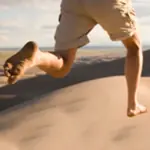As you likely know, the hip is a huge ball and socket joint that is relatively stable and yet maintains a fair amount of joint range of motion. Because running is a repetitive motion which requires that our lower limbs bear 2.5X our body weight each step, the hips take a great deal of load in any amount of distance we run. What's helpful to know is that strength is only one component of well-functioning hips. Many people rightly attempt to strengthen the muscles surrounding the hip joint but what they may neglect are exercises which train their hip control and stability. This is especially important for runners as we are essentially hopping from one foot to another. If you have poor coordination and balance on one leg, you cannot control loads very well when you're running. Symptoms of poor hip control can manifest in lower extremity injuries or areas of chronic stiffness (i.e. tight regardless how much you stretch).
So without further ado, give these exercises a try in your running routine for a few weeks and see if you find your stride feeling smoother and your body less sore overall. I typically do a few of these exercises pre/post run and will sometimes do longer sessions on days that I do not run. Shoot for 3 sets of 10-15 repetitions for the first 3 exercises and 5 rounds for each leg on the Star Reaches. Finally, using a mirror or other visual feedback may also help ensure your form is correct.
1. Hip Drops
Start on a step with a level pelvis, keep both knees straight during the entire exercise. Lower your leg SLOWLY by pushing the hip of your stance leg out to the side. This will cause your pelvis to drop on one side. Avoid leaning your torso. Raise your pelvis back to the starting position using the hip of your stance leg. You should feel the work mostly in the side of the hip of the leg you're standing on.
 |
| Starting position with a level pelvis. |
 |
| Starting position |
 |
| Finish position. Keep your balance and a tall spine! |
3. Single Leg Romanian Deadlifts
Stand on one leg with a slight bend in the knee. The goal of this exercise is to bend forward from the hip as much as possible without moving the spine. Keep your spine straight during the entire exercise, your back leg should remain extended in line with your spine. To bend forward, push your hip back until you feel a good stretch in your glute muscle. Once the hip stops bending, return to the starting position using your hip (not extending with your back).
 |
| Starting position. |
 |
| Forward reaching. |
 |
| Side reaching. |
 |
| Contralateral posterior reach. |








